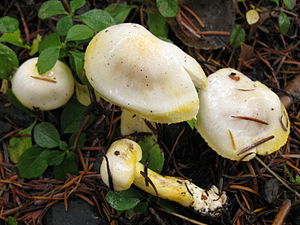Gold tooth snail
| Gold tooth snail | ||||||||||||
|---|---|---|---|---|---|---|---|---|---|---|---|---|

Gold-tooth snail ( Hygrophorus chrysodon ) |
||||||||||||
| Systematics | ||||||||||||
|
||||||||||||
| Scientific name | ||||||||||||
| Hygrophorus chrysodon | ||||||||||||
| ( Batsch : Fr. ) Fr. |
The gold-tooth snail or yellow- flaky snail ( Hygrophorus chrysodon ) is a type of mushroom from the family of snail relatives .
features
Macroscopic features
The hat measures 2–7 cm in diameter, is arched when young, later flattens and develops a blunt hump. The surface is smooth, whitish when young and later yellowish in color, yellowing on pressure and has a weak pattern of ingrown radial fibers. In damp weather it is very slimy and greasy, dry matt. The brim of the hat is initially rolled up. The shiny golden or lemon-yellow flakes that give it its name are attached to it. Sometimes there are also yellow flakes on the middle of the hat, which represent remains of the Velum universale . The thick lamellas are a little distant and have grown on the stem until they run down. Especially when young, they sometimes have a yellow flaky edge. The lamellar surface is white to cream-colored. Later they have a pale pink-yellowish tinge. The spore powder is white. The cylindrical stem is 3–8 cm long and 5–15 mm thick, cylindrical in shape and filled with full flesh or woolly. Its surface has a white to pale yellow color and is finely flaked yellow, especially at the tip. The flesh is white, sometimes yellowish under the surface of the cap and handle. It is juicy, tastes mild and smells slightly sour-aromatic, somewhat reminiscent of the caterpillar of the willow borer . Meat and surfaces react with a yellow discoloration when they come into contact with alkalis such as potassium hydroxide (KOH).
Microscopic features
The spores are elliptical to spindle-elliptical, 7-10 micrometers long and 3.5-5 micrometers wide; their surface is smooth. They are hyaline and have drops in them. Four of them each mature to the basidia . These are cylindrical-club-shaped and measure 35–45 × 5.5–7 µm. They have a buckle at their base . There are no cystids . The hat skin (Pileipellis) is an ixocutis made up of cylindrical to wavy, partially bifurcated hyphae 1.5-4 µm wide. They are embedded in a slimy mass from which individual hyphae ends protrude. The septa have buckles.
Species delimitation
With age, the surface of the fruiting body can become largely white and lose flocking or flakes and then become difficult to distinguish. The potassium hydroxide reaction then clearly distinguishes it from other snails.
It resembles the discoloring snail ( Hygrophorus discoxanthus ), which is hardly suitable for consumption due to its intrusive taste. It forms somewhat larger fruiting bodies that smell like vinegar and are particularly found in beeches.
Ecology and phenology
The gold-tooth snail is a mycorrhizal fungus that lives in symbiosis with deciduous and coniferous trees . These include above all the common beech and the common spruce . It can be found in mesophile and calciphile beech and beech-fir forests with or without spruce. These are mainly woodruff beech forests . However, it can also be found in subsequent forests with spruce of these forest types. In contrast, the fungus hardly occurs in parks, gardens and similar biotopes. The species colonizes fresh to soaky, neutral to strongly alkaline, mild humus, sandy to loamy soils that are clearly saturated with bases but not too rich in nutrients. Thus it grows in brown clay rendzinen , brown and parabrown soils . These are located above lime , lime sand or marl . The fungus can also be found on acidic soils if enough lime is brought into the soil through the gravel of paths or roads or fertilization .
The fructification takes place between August and November, especially in October. The fruiting bodies appear solitary to gregarious.
distribution
The gold-tooth snail is widespread in the Holarctic from meridional to temperate . It can be found in North America (USA, Canada), Europe and North Asia (Eastern Siberia, Korea, Japan). In Europe, the area extends from Great Britain and France in the west to the Czech Republic, to Slovakia and Hungary in the east and south to Spain, Italy and Romania and north to the Hebrides , central Fennoscandinavia and Estonia.
Systematics
The official scientific first description goes back to a part of the work "Elenchus Fungorum" by August Batsch published in 1789 . The specific epithet "chrysodon" from the scientific name means "gold tooth".
There is a var. Leucodon in which the yellow flakes are missing. In addition, a var. Incarnatum has been described that has flesh-colored lamellae or reddish discolouring flesh.
meaning
The gold tooth snail is edible and is used as an edible mushroom .
swell
literature
- German Josef Krieglsteiner (Ed.), Andreas Gminder : Die Großpilze Baden-Württemberg . Volume 3: Mushrooms. Leaf mushrooms I. Ulmer, Stuttgart 2001, ISBN 3-8001-3536-1 .
- Lexemuel Ray Hesler, Alexander Hanchett Smith: North American Species of Hygrophorus . 1st edition. University of Tennessee Press, Knoxville, Tennessee, USA 1963, p. 249 ff . (English, umich.edu ).
- Michael Kuo: Hygrophorus chrysodon. In: MushroomExpert.com website. Retrieved September 30, 2011 .
- Markus Flück: Which mushroom is that? 3. Edition. Franckh-Kosmos Verlags-GmbH & Co. KG, Stuttgart 2009, ISBN 978-3-440-11561-9 , p. 134 .
- Hans E. Laux: The great cosmos mushroom guide. All edible mushrooms with their poisonous doppelgangers. Franckh-Kosmos, Stuttgart 2001, ISBN 3-440-08457-4 , p. 98.
Individual evidence
- ↑ Josef Breitenbach, Fred Kränzlin (Ed.): Pilze der Schweiz. Contribution to knowledge of the fungal flora in Switzerland. Volume 3: Bolete and agaric mushrooms. Part 1: Strobilomycetaceae and Boletaceae, Paxillaceae, Gomphidiacea, Hygrophoracea, Tricholomataceae, Polyporaceae (lamellar). Mykologia, Luzern 1991, ISBN 3-85604-030-7 , p. 120 (for the entire paragraph).
Web links
- Hygrophorus chrysodon at MushroomExpert.com
- Hygrophorus chrysodon at RogersMushrooms
- California Fungi - Hygrophorus chrysodon at MykoWeb